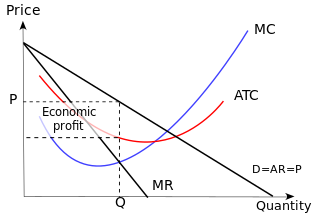Related Research Articles

Marketing is the process of exploring, creating, and delivering value to meet the needs of a target market in terms of goods and services; potentially including selection of a target audience; selection of certain attributes or themes to emphasize in advertising; operation of advertising campaigns; attendance at trade shows and public events; design of products and packaging attractive to buyers; defining the terms of sale, such as price, discounts, warranty, and return policy; product placement in media or with people believed to influence the buying habits of others; agreements with retailers, wholesale distributors, or resellers; and attempts to create awareness of, loyalty to, and positive feelings about a brand. Marketing is typically done by the seller, typically a retailer or manufacturer. Sometimes tasks are contracted to a dedicated marketing firm or advertising agency. More rarely, a trade association or government agency advertises on behalf of an entire industry or locality, often a specific type of food, food from a specific area, or a city or region as a tourism destination.
In marketing jargon, product lining refers to the offering of several related products for individual sale. Unlike product bundling, where several products are combined into one group, which is then offered for sale as a units, product lining involves offering the products for sale separately. A line can comprise related products of various sizes, types, colors, qualities, or prices. Line depth refers to the number of subcategories under a category. Line consistency refers to how closely related the products that make up the line are. Line vulnerability refers to the percentage of sales or profits that are derived from only a few products in the line.

Distribution is one of the four elements of the marketing mix. Distribution is the process of making a product or service available for the consumer or business user who needs it. This can be done directly by the producer or service provider or using indirect channels with distributors or intermediaries. The other three elements of the marketing mix are product, pricing, and promotion.

Pricing is the process whereby a business sets the price at which it will sell its products and services, and may be part of the business's marketing plan. In setting prices, the business will take into account the price at which it could acquire the goods, the manufacturing cost, the marketplace, competition, market condition, brand, and quality of product.
Price skimming is a price setting strategy that a firm can employ when launching a product or service for the first time. By following this price skimming method and capturing the extra profit a firm is able to recoup its sunk costs quicker as well as profit off of a higher price in the market before new competition enters and lowers the market price. It has become a relatively common practice for managers in new and growing market, introducing prices high and dropping them over time.
Porter's generic strategies describe how a company pursues competitive advantage across its chosen market scope. There are three/four generic strategies, either lower cost, differentiated, or focus. A company chooses to pursue one of two types of competitive advantage, either via lower costs than its competition or by differentiating itself along dimensions valued by customers to command a higher price. A company also chooses one of two types of scope, either focus or industry-wide, offering its product across many market segments. The generic strategy reflects the choices made regarding both the type of competitive advantage and the scope. The concept was described by Michael Porter in 1980.
In theories of competition in economics, a barrier to entry, or an economic barrier to entry, is a fixed cost that must be incurred by a new entrant, regardless of production or sales activities, into a market that incumbents do not have or have not had to incur. Because barriers to entry protect incumbent firms and restrict competition in a market, they can contribute to distortionary prices and are therefore most important when discussing antitrust policy. Barriers to entry often cause or aid the existence of monopolies and oligopolies, or give companies market power. Barriers of entry also have an importance in industries. First of all it is important to identify that some exist naturally, such as brand loyalty. Governments can also create barriers to entry to meet consumer protection laws, protecting the public. In other cases it can also be due to inherent scarcity of public resources needed to enter a market.
Product churning is the business practice whereby more of the product is sold than is beneficial to the consumer. An example is a stockbroker who buys and sells securities in a portfolio more frequently than is necessary, in order to generate commission fees.
Market penetration refers to the successful selling of a good or service in a specific market. It is measured by the amount of sales volume of an existing good or service compared to the total target market for that product or service. Market penetration is the key for a business growth strategy stemming from the Ansoff Matrix (Richardson, M., & Evans, C.. H. Igor Ansoff first devised and published the Ansoff Matrix in the Harvard Business Review in 1957, within an article titled "Strategies for Diversification". The grid/matrix is utilized across businesses to help evaluate and determine the next stages the company must take in order to grow and the risks associated with the chosen strategy. With numerous options available, this matrix helps narrow down the best fit for an organization.
Predatory pricing is a pricing strategy, using the method of undercutting on a larger scale, where a dominant firm in an industry will deliberately reduce the prices of a product or service to loss-making levels in the short-term. The aim is that existing or potential competitors within the industry will be forced to leave the market, as they are unable to effectively compete with the dominant firm without making a loss. Once competition has been eliminated, the dominant firm now having a majority share of the market can raise its prices to monopoly levels in the long-term to recoup its losses.

Non-price competition is a marketing strategy "in which one firm tries to distinguish its product or service from competing products on the basis of attributes like design and workmanship". It often occurs in imperfectly competitive markets because it exists between two or more producers that sell goods and services at the same prices but compete to increase their respective market shares through non-price measures such as marketing schemes and greater quality. It is a form of competition that requires firms to focus on product differentiation instead of pricing strategies among competitors. Such differentiation measures allowing for firms to distinguish themselves, and their products from competitors, may include, offering superb quality of service, extensive distribution, customer focus, or any sustainable competitive advantage other than price. When price controls are not present, the set of competitive equilibria naturally correspond to the state of natural outcomes in Hatfield and Milgrom's two-sided matching with contracts model.
In the theories of competition in economics, strategic entry deterrence is when an existing firm within a market acts in a manner to discourage the entry of new potential firms to the market. These actions create greater barriers to entry for firms seeking entrance to the market and ensure that incumbent firms retain a large portion of market share or market power. Deterring strategies, might include an excess capacity, limit pricing, predatory pricing, predatory acquisition and switching costs. Although in the short run, entry deterring strategies might lead to a firm operating inefficiently, in the long run the firm will have a stronger holder over market conditions.

A business can use a variety of pricing strategies when selling a product or service. To determine the most effective pricing strategy for a company, senior executives need to first identify the company's pricing position, pricing segment, pricing capability and their competitive pricing reaction strategy. Pricing strategies and tactics vary from company to company, and also differ across countries, cultures, industries and over time, with the maturing of industries and markets and changes in wider economic conditions.
Supracompetitive pricing is pricing above what can be sustained in a competitive market. This may be indicative of a business that has a unique legal or competitive advantage or of anti-competitive behavior that has driven competition from the market.
In economic literature, the term "aftermarket" refers to a secondary market for the goods and services that are 1) complementary or 2) related to its primary market goods. In many industries, the primary market consists of durable goods, whereas the aftermarket consists of consumable or non-durable products or services.
The following outline is provided as an overview of and topical guide to marketing:
A marketing channel consists of the people, organizations, and activities necessary to transfer the ownership of goods from the point of production to the point of consumption. It is the way products get to the end-user, the consumer; and is also known as a distribution channel. A marketing channel is a useful tool for management, and is crucial to creating an effective and well-planned marketing strategy.

The razor and blades business model is a business model in which one item is sold at a low price in order to increase sales of a complementary good, such as consumable supplies. It is different from loss leader marketing and free sample marketing, which do not depend on complementary products or services. Common examples of the razor and blades model include inkjet printers whose ink cartridges are significantly marked up in price, and video game consoles which require additional purchases to obtain accessories and software not included in the original package.
Customer cost refers not only to the price of a product, but it also encompasses the purchase costs, use costs and the post-use costs. Purchase costs consist of the cost of searching for a product, gathering information about the product and the cost of obtaining that information. Usually, the highest use costs arise for durable goods that have a high demand on resources, such as energy or water, or those with high maintenance costs. Post-use costs encompass the costs for collecting, storing and disposing of the product once the item has been discarded.
Product strategy defines the high-level plan for developing and marketing a product, how the product supports the business strategy and goals, and is brought to life through product roadmaps. A product strategy describes a vision of the future with this product, the ideal customer profile and market to serve, go-to-market and positioning (marketing), thematic areas of investment, and measures of success. A product strategy sets the direction for new product development. Companies utilize the product strategy in strategic planning and marketing to set the direction of the company's activities. The product strategy is composed of a variety of sequential processes in order for the vision to be effectively achieved. The strategy must be clear in terms of the target customer and market of the product in order to plan the roadmap needed to achieve strategic goals and give customers better value.
References
- ↑ J Dean (1976). "Pricing Policies for New Products". Harvard Business Review. 54 (6): 141–153.
- ↑ GJ Tellis (1986). "Beyond the Many Faces of Price: An Integration of Pricing Strategies". Journal of Marketing. 50 (October): 146–160. doi:10.1177/002224298605000402.
- ↑ Penetration Pricing
- ↑ M Spann; M Fischer; GJ Tellis (2015). "Skimming or Penetration? Strategic Dynamic Pricing for New Products". Marketing Science. 34 (2): 235–249. doi:10.1287/mksc.2014.0891.